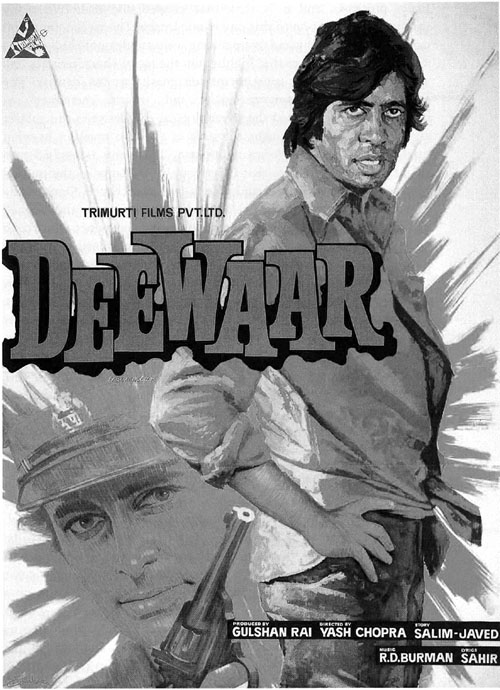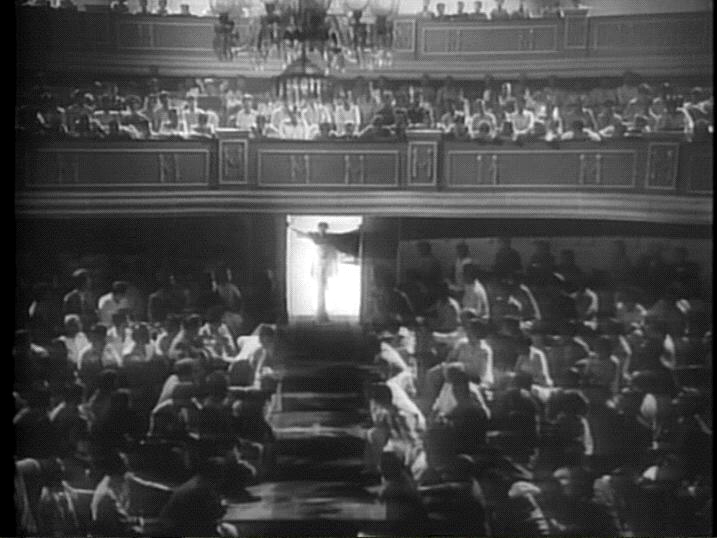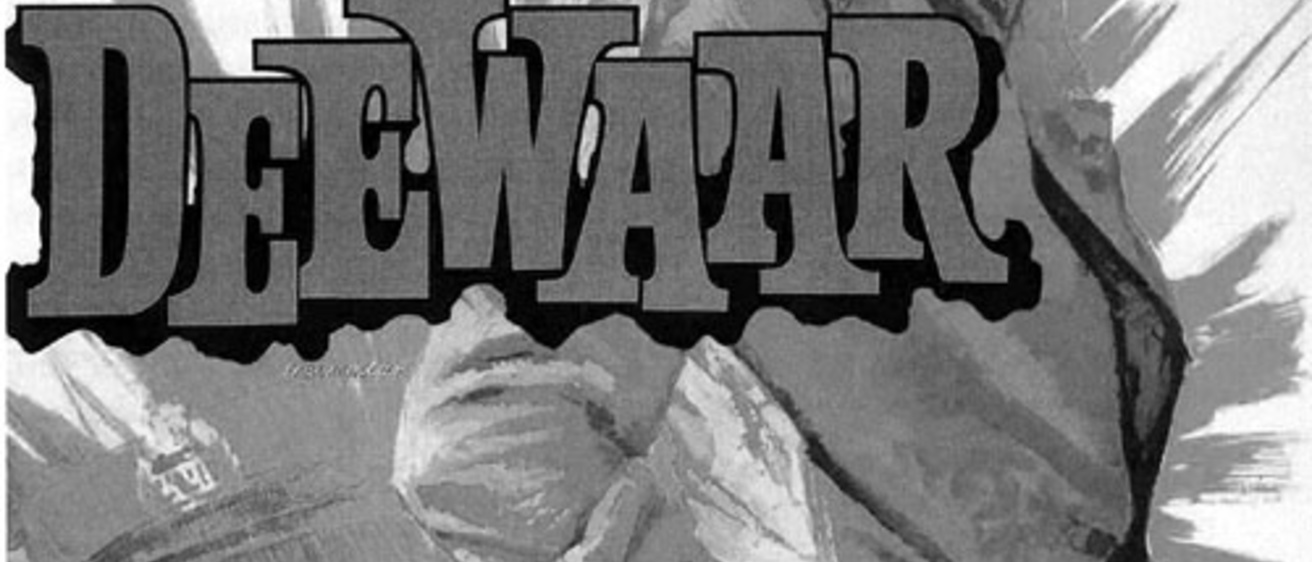Topics in Asian Cinema: Popular Hindi Cinema
048:106 (039:145, 008:127)
University of Iowa
Fall 2004

Class Meetings: Tuesday & Thursday, 12:20 – 1:35 p.m., 101 BCSB
Film Screenings: Monday, 7-10 p.m., 101 BCSB
Professors:
Corey K. Creekmur, Departments of English, Cinema & Comparative Literature
Philip Lutgendorf, Department of Asian Languages and Literature
Required Texts (available at Prairie Lights):
Nasreen Munni Kabir, Bollywood: The Indian Cinema Story (Channel 4 Books)
Vijay Mishra, Bollywood Cinema: Temples of Desire (Routledge)
Coursepack [available at Zephyr Copies downtown]
Recommended Texts (especially for graduate students):
Gayatri Chatterjee, Awara (Penguin India)
Gayatri Chatterjee, Mother India (BFI)
Anupama Chopra, Dilwale Dulhania Le Jayenge (BFI)
Madhava Prasad, Ideology of the Hindi Film: A Historical Construction (Oxford India)
Jyotika Virdi, The Cinematic ImagiNation: Indian Popular Films as Social History (Rutgers UP)
Readings on Reserve in Main Library
Course Requirements:
- Essays: Four short essays (3-5 pp. each) that synthesize your thoughts on the films, readings, and class discussions: the format for the essays will be discussed in class. Ideally, each essay should include discussion of at least two of the required films for the course and should refer to some of the relevant assigned readings. Each essay will be worth 15% of your total grade. Essays are due in class on the following dates:
Tuesday, September 21 (Week 5)
Tuesday, October 12 (Week 8)
Tuesday, November 2 (Week 11)
Thursday, December 2 (Week 14)
- Exam: There will be a final exam at the scheduled time (12:00 p.m., Thursday, December 16th) worth roughly 30% of your final grade.
- Class Participation: while some portions of this class will be devoted to lectures, most of the class will involve active discussion. You should always come to class prepared to discuss the material relevant to each session. Note also that attendance at Monday night screenings is a required component of the course. Attendance will be taken periodically, and repeated, unexcused absence will seriously affect your final grade. Class participation will count for roughly 10% of the final grade.
Graduate Students: graduate students taking the class should expect to do additional reading and perhaps viewing for the course; a number of times during the semester we will plan additional meetings in addition to class sessions to discuss texts and topics appropriate for graduate-level research on Hindi cinema; course requirements will also be adjusted appropriately.
Syllabus:
WEEK 1: August 23, 24, 26: Introduction to Popular Hindi Cinema
Screening: Dil Se [“From the Heart”] (Mani Rathnam, 1998, 155m)
Required Readings:
Nasreen Munni Kabir, Bollywood: Chapter 1, “Bollywood Basics”: 1-23.
Rosie Thomas, “Indian Cinema: Pleasures and Popularity,” Screen 26:3-4 (May-August 1985): 116-131. [coursepack]
Additional Resources:
Wimal Dissanayake, “Rethinking Indian Popular Cinema: Towards Newer Frames of Understanding,” in Rethinking Third Cinema, ed. Anthony R. Guneratne and Wimal Dissanayke (London: Routledge, 2003): 202-225.
Sumita S. Chakravarty, “Fragmenting the Nation: Images of Terrorism in Indian Popular Cinema,” in Cinema & Nation, eds. Mette Hjort and Scott MacKenzie (London: Routledge, 2000): 222-237.
Ananya Jahanara Kabir, “Allegories of Alienation and Politics of Bargaining: Minority Subjectivities in Mani Rathnam’s Dil Se,” South Asian Popular Culture 1: (2003): 141-159.
------------------------------------------------------------------------------------------------------------
WEEK 2: August 30, 31, September 2: Post-Independence Hindi Cinema
Screening: Awara [“The Vagabond”] (Raj Kapoor, 1951, 168m)
Required Readings:
Vijay Mishra, Bollywood Cinema: Chapter 4, “Auteurship and the Lure of Romance”: 89-112.
Jacob Levich, “Freedom Songs: Rediscovering Bollywood’s Golden Age,” Film Comment May-June 2002): 48-51. [coursepack]
Additional Resources:
Gayatri Chatterjee, Awara (New Delhi: Penguin Books India, 2003).
Wimal Dissanayake and Malti Sahai, Raj Kapoor’s Films: Harmony of Discourses (New Delhi: Vikas, 1988).
Ravi S. Vasudevan, “Addressing the Spectator of a `Third World’ National Cinema: The Bombay `Social’ Film of the 1940s and 1950s,” Screen 36:4 (Winter 1995): 305-324.
Ravi S. Vasudevan, “Shifting Codes, Dissolving Identities: The Hindi Social Film of the 1950s as Popular Culture,” in Making Meaning in Indian Cinema, ed. Vasudevan (New Delhi: Oxford, 2000): 99-121.
------------------------------------------------------------------------------------------------------------
WEEK 3: September 7 and 9: Cultural Backgrounds of Hindi Cinema
[No Film Screening: Labor Day]
Required Readings:
Nasreen Munni Kabir, Bollywood, Chapter 5, “Working Wonders,” Chapter 6, “Calling the Shots” and Chapter 7, “Singing Through the Ages”: 103-182.
Vijay Mishra, Bollywood Cinema, Chapter 1, “Inventing Bombay Cinema,” and Chapter 2, “Melodramatic Staging”: 1-59.
Mukul Kesavan, “Urdu, Awadh, and the Tawaif: The Islamicate Roots of Hindi Cinema,” in Forging Identities: Gender, Communities, and the State ed. Zoya Hasan (New Delhi: Kali for Women, 1994): 244-257. [coursepack]
Additional Resources:
Ashish Rajadhyaksha, “The Phalke Era: Conflict of Traditonal Form and Modern Technology,” in Interrogating Modernity: Culture and Colonialism in India, ed. Tejaswini Niranjana, P. Sudhir, and Vivek Dhareshwar (Calcutta: Seagull Books, 1993): 47-82.
------------------------------------------------------------------------------------------------------------
WEEK 4: September 13, 14, 16: The National Epic
Screening: Mother India (Mehboob Khan, 1957, 168m)
Required Readings:
Rosie Thomas, “Sanctity and Scandal: The Mythologization of Mother India,” Quarterly Review of Film and Video 11:3 (1989): 11-30. [coursepack]
Vijay Mishra, Bollywood Cinema, Chapter 3, “The Texts of ‘Mother India’: 61-87.
Additional Resources:
Parama Roy, “Figuring Mother India: The Case of Nargis,” in Indian Traffic: Identities in Question in Colonial and Postcolonial India (Berkeley: U of California P, 1998): 152-173.
Gayatri Chatterjee, Mother India (London: BFI, 2002).
------------------------------------------------------------------------------------------------------------
WEEK 5: September 20, 21, 23: The Genius of Guru Dutt
Screening: Pyaasa [“The Thirsty One”] (Guru Dutt, 1957, 139m)
Required Readings:
Vijay Mishra, Bollywood Cinema, Chapter 4, “Auteurship and the Lure of Romance”: 112-123.
Nasreen Munni Kabir, “Pyaasa,” in Guru Dutt: A Life in Cinema (New Delhi: Oxford UP India, 1997): 75-88. [coursepack]
Darius Cooper, “The Hindi Film Song and Guru Dutt,” East-West Film Journal 2:2 (1988): 49-65. [coursepack]
Daisy Rockwell, “Visionary Choreographies: Guru Dutt’s Experiments in Film Song Picturisation,” South Asian Popular Culture 1:2 (October 2003): 109-124. [coursepack]
Additional Resources:
Alison Griffiths, “Discourses of Nationalism in Guru Dutt’s Pyaasa,” Deep Focus VI (1996): 24-31.
Neepa Majumdar, “The Embodied Voice: Song Sequences and Stardom in Popular Hindi Cinema,” in Soundtrack Available: Essays on Film and Popular Music, eds. Pamela Robertson Wojcik and Arthur Knight (Durham: Duke UP, 2001): 161-181.
------------------------------------------------------------------------------------------------------------
WEEK 6: September 27, 28, 30: The Courtesan Film
Screening: Umrao Jaan (Muzaffar Ali, 1981, 145m)
Required Readings:
Sumita Chakravarty, selection from Chapter 8, “Woman and the Burden of Postcoloniality: The Courtesan Film Genre,” in National Identity in Indian Popular Cinema 1947-1987 (Austin: U of Texas P, 1993): 269-293. [coursepack]
Veena Talwar Oldenberg, “Lifestyle as Resistance: The Case of the Courtesans of Lucknow,” in Contesting Power: Resistance and Everyday Social Relations in South Asia, ed. Douglas Haynes and Gyan Prakash (Berkeley: U of California P, 1992): 23-61. [coursepack]
Additional Resources:
Mirza Mohammad Hadi Ruswa, Umrao Jan Ada, trans. Khushwant Singh and M.A. Husaini (Hyderabad: Disha Books, 1993) [note: this translation is preferable to the later version by David Matthews, 1996]
Fareed Kazmi, “Muslim Socials and the Female Protagonist: Seeing a Dominant Discourse at Work,” in Forging Identities: Gender, Communities, and the State, ed. Zoya Hasan (New Delhi: Kali for Women, 1994): 226-243.
------------------------------------------------------------------------------------------------------------
WEEK 7: October 4, 5,7: The Historical (Part I)
Screening: Mughal-e-Azam [“The Great Mughal”] (K. Asif, 1960, 198m)
Required Readings:
Ziauddin Sardar, “Dilip Kumar Made Me Do It,” in The Secret Politics of Our Desires: Innocence, Culpability and Indian Popular Cinema, ed. Ashis Nandy (London: Zed Books, 1998): 19-91.
Additional Resources:
Sumita S. Chakravarty, selection from Chapter 5, “The Recuperation of History and Memory,” in National Identity in Indian Popular Cinema 1947-1987 (Austin: U of Texas P, 1993): 157-173.
------------------------------------------------------------------------------------------------------------
WEEK 8: October 11, 12, 14: The Mythological and its Audiences
Screening: Jai Santoshi Maa [“Hail Mother Santoshi”] (Vijay Sharma, 1975, 138m)
Required Readings:
Nasreen Munni Kabir, Bollywood, Chapter 8, “Dancing to the Music”: 183-199.
Philip Lutgendorf, “Who Wants to be a Goddess?: Jai Santoshi Maa Revisted” [manuscript, coursepack]
Additional Resources:
Veena Das, “The Mythological Film and its Framework of Meaning: An Analysis of Jai Santoshi Maa,” India International Centre Quarterly 8:1 (1980): 43-56.
------------------------------------------------------------------------------------------------------------
WEEK 9: October 18, 19, 21: The Angry Young Superstar
Screening: Deewar [“The Wall”] (Yash Chopra, 1975, 174m)
Required Readings:
Vijay Mishra, Bollywood Cinema, Chapter 5, “The Actor as Parallel Text: Amitabh Bachchan”: 125-156.
Additional Resources:
Jyotika Virdi, 1993. “The `Fiction’ of Film and `Fact’ of Politics: Deewar.” Jump Cut 38 (1993): 26-32.
Fareeduddin Kazmi, “How Angry is the Angry Young Man? `Rebellion’ in Conventional Hindi Films,” in The Secret Politics of Our Desires: Innocence, Culpability and Indian Popular Cinema, ed. Ashis Nandy. (London: Zed Books, 1998): 134-156.
Vinay Lal, “The Impossibility of the Outsider in the Modern Hindi Film,” in The Secret Politics of Our Desires: Innocence, Culpability and Indian Popular Cinema, ed. Ashis Nandy. (London: Zed Books, 1998): 228-259.
Ranjani Mazumdar, 2000. “From Subjectification to Schizophrenia: The 'Angry Man' and the 'Psychotic' Hero of Bombay Cinema,” in Making Meaning in Indian Cinema, ed. Ravi S. Vasudevan. (New Delhi: Oxford University Press, 2000): 238-264.
Ashwani Sharma, “Blood, Sweat and Tears: Amitabh Bachchan, Urban Demi-god,” in You Tarzan: Masculinity, Movies and Men, ed. Pat Kirkham and Janet Thumim (New York: St. Martin’s Press, 1993): 167-180.
Lalit Vachani, “Bachchan-alias: The Many Faces of a Film Icon,” in Image Journeys: Audio-Visual Media & Cultural Change in India, eds. Christiane Brosius and Melissa Butcher (New Delhi: Sage Publications India Pvt Ltd, 1999): 199-230.
------------------------------------------------------------------------------------------------------------
WEEK 10: October 25, 26, 28: Gender and The Social
Screening: Sahib, Bibi, aur Ghulam [“Master, Wife, and Servant”] (Abrar Alvi/Guru Dutt, 1962, 154m)
Required Readings:
Nasreen Munni Kabir, “Sahib, Bibi aur Ghulam,” in Guru Dutt: A Life in Cinema (Delhi: Oxford UP India, 1997): 109-121.
Additional Resources:
Sumita S. Chakravarty, selection from Chapter 5, “The Recuperation of History and Memory,” in National Identity in Indian Popular Cinema 1947-1987 (Austin: U of Texas P, 1993): 173-184.
------------------------------------------------------------------------------------------------------------
WEEK 11: November 1, 2, 4: The Masala Film
Screening: Amar, Akbar, Anthony (Manmohan Desai, 1977, 174m)
Required Readings:
Rosie Thomas, “Melodrama and the Negotiation of Morality in Mainstream Hindi Film,” in Consuming Modernity: Public Culture in a South Asian World. Ed. Carol A. Breckenridge (Minneapolis: University of Minnesota Press, 1995): 157-182.
Additional Resources:
Vijay Mishra, Bollywood Cinema, Chapter 6, “Segmenting/Analyzing Two Foundational Texts”: 157-201.
------------------------------------------------------------------------------------------------------------
WEEK 12: November 8, 9, 11: The Historical (Part II): Remembering Partition
Screening: Hey Ram [“Oh, God!”] (Kamal Hassan, 2000, 186m)
Required Readings:
Vijay Mishra, Bollywood Cinema, Chapter 7, “After Ayodha: The Sublime Object of Fundamentalism”: 203-233.
Additional Resources:
Ravi Vasudevan, “Another History Rises to the Surface: ‘Hey Ram’ – Melodrama in the Age of Digital Simulation,” Economic and Political Weekly 27:28 (July 13, 2002): 2917-2925.
------------------------------------------------------------------------------------------------------------
WEEK 13: November 15, 16, 18: Romance, Consumerism, and Diaspora
Screening: Dilwale Dulhaniya Le Jayenge [“The Brave Heart Takes the Bride”] (Aditya Chopra, 1995, 190m)
Required Readings:
Vijay Mishra, Bollywood Cinema, Chapter 8, “Bombay Cinema and Diasporic Desire”: 235-269.
Patricia Uberoi, “The Diaspora Comes Home: Disciplining Desire in DDLJ,” Contributions to Indian Sociology 32:2 (July-December 1988): 305-336. [coursepack]
Additional Resources:
Anupama Chopra, Dilwale Dulhania Le Jayenge (London: BFI, 2002).
Rachel Dwyer, All You Want Is Money, All You Need Is Love: Sex and Romance in Modern India (London: Cassell, 2000).
Ronald Inden, “Transnational Class, Erotic Arcadia and Commercial Utopia in Hindi Films,” in Image Itineraries: Audio-Visual Media and Cultural Change in India, ed. Christiane Brosius and Melissa Butcher (New Delhi: Sage, 1999): 41-66.
Andrew Willis, “Locating Bollywood: Notes on the Hindi Blockbuster, 1975 to the Present,” in Movie Blockbusters, ed. Julian Stringer (London: Routledge, 2003): 255-268.
------------------------------------------------------------------------------------------------------------ THANKSGIVING HOLIDAY
------------------------------------------------------------------------------------------------------------
WEEK 14: November 29, 30, December 2: Bombay Noir
Screening: Satya [“Truth”] (Ram Gopal Verma, 1998, 175m)
Required Readings:
Travis Crawford, “Bullets Over Bombay: Exposing the Underworld of Hindi Cinema (Both Onscreen and Off),” Film Comment (May-June 2002): 53-55. [coursepack]
Ravi Vasudevan, “The Exhilaration of Dread: Genre, Narrative Form and Film Style in Contemporary Urban Action Films,” Sarai Reader 2002: The Cities of Everyday Life (New Delhi, 2002): 59-67. [coursepack]
------------------------------------------------------------------------------------------------------------
WEEK 15: December 6, 7, 9: Globalized Youth
Screening: Dil Chatha Hai [“The Heart Yearns”] (Farhan Akhtar, 2001, 185m)
Required Readings:
Corey K. Creekmur, “Bombay Boys: Dissolving the Male Child in Popular Hindi Cinema,” in Where the Boys Are: Cinemas of Boyhood, ed. Murray Pomerance and Frances Gateward. (Detroit: Wayne State UP, 2004): [coursepack]
------------------------------------------------------------------------------------------------------------
Final Exam: 12:00 p.m. Thursday, December 16 (room to be announced)

